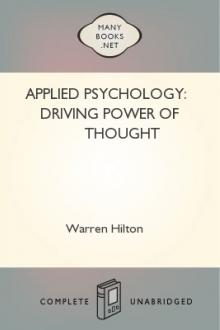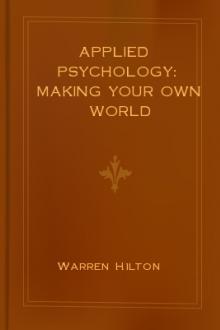Power of Mental Imagery by Warren Hilton (best free e reader TXT) 📕

- Author: Warren Hilton
- Performer: -
Book online «Power of Mental Imagery by Warren Hilton (best free e reader TXT) 📕». Author Warren Hilton
The Project Gutenberg EBook of Power of Mental Imagery, by Warren Hilton
This eBook is for the use of anyone anywhere at no cost and with
almost no restrictions whatsoever. You may copy it, give it away or
re-use it under the terms of the Project Gutenberg License included
with this eBook or online at www.gutenberg.org
Title: Power of Mental Imagery
Being the Fifth of a Series of Twelve Volumes on the
Applications of Psychology to the Problems of Personal and
Business Efficiency
Author: Warren Hilton
Release Date: September 2, 2007 [EBook #22489]
Language: English
*** START OF THIS PROJECT GUTENBERG EBOOK POWER OF MENTAL IMAGERY ***
Produced by David Clarke, Suzan Flanagan and the Online
Distributed Proofreading Team at http://www.pgdp.net (This
file was produced from images generously made available
by The Internet Archive/Million Book Project)
Applied Psychology
POWER OFMENTAL IMAGERY
Being the Fifth of a Series of
Twelve Volumes on the Applications
of Psychology to the Problems of
Personal and Business
Efficiency
BY
WARREN HILTON, A.B., L.L.B.
FOUNDER OF THE SOCIETY OF APPLIED PSYCHOLOGY
ISSUED UNDER THE AUSPICES OF
THE LITERARY DIGEST
FOR
The Society of Applied Psychology
NEW YORK AND LONDON
1920
COPYRIGHT 1914
BY THE APPLIED PSYCHOLOGY PRESS
SAN FRANCISCO
(Printed in the United States of America)
CONTENTS Chapter I. IMAGINATION AND RECOGNITIONPage RECOGNIZING THE PAST AS PAST3 IMAGINATION, PAST, PRESENT AND FUTURE5 II. KINDS OF MENTAL IMAGES VISUAL IMAGERY9 AUDITORY IMAGERY11 IMAGERY OF TASTE AND SMELL12 MUSCULAR AND TACTUAL IMAGERY13 PERSONAL DIFFERENCES IN MENTAL IMAGERY14 INVESTIGATIONS OF DOCTOR GALTON15 INVESTIGATIONS OF PROFESSOR JAMES16 INVESTIGATIONS OF PROFESSOR SCOTT21 III. HOW TO INFLUENCE OTHERSTHROUGH MENTAL IMAGERY A RULE FOR INFLUENCING OTHERS31 APPLICATION TO PEDAGOGY32 HOW TO SELL GOODS BY MENTAL IMAGERY33 A STUDY OF ADVERTISEMENTS34 THE WORDS THAT CREATE DESIRE35 A KEY FOR SELECTING A CALLING36 IV. HOW TO TEST YOUR MENTAL IMAGERY FINDING OUT YOUR WEAK POINTS39 TESTS FOR VISUAL IMAGERY40 TESTS FOR AUDITORY AND OLFACTORY IMAGERY42 TESTS FOR IMAGERY OF TASTE AND TOUCH43 TESTS FOR IMAGERY OF HEAT AND COLD44 HOW TO CULTIVATE MENTAL IMAGERY45 V. THE CREATIVE IMAGINATION THE PROCESS OF CREATIVE IMAGINATION49 BUSINESS AND FINANCIAL IMAGINATION50 HOW WEALTH IS CREATED51 THE KLAMATH PHILOSOPHY52 HOW MEN GET THINGS53 PREREQUISITES TO ACHIEVEMENT54 HOW TO TAKE RADICAL STEPS IN BUSINESS55 THE EXPANSION OF BUSINESS IDEALS57 RISING TO THE EMERGENCY58 THE CONSTRUCTIVE IMAGINATION59 LITTLE TASKS AND BIG TASKS60 WORKING UP A DEPARTMENT61 IMAGINATION IN HANDLING EMPLOYEES62 HOW TO TEST AN EMPLOYEE’S IMAGINATION63 IMAGINATION IN BUSINESS GENERALLY64 IMAGINATION AND ACTION65 IMAGINATION AND
RECOGNITION
In the preceding volume of this Course, entitled “The Trained Memory,” you learned that the memory process involves four elements, Retention, Recall, Recognition and Imagination; and the scope and operation of two of these elements, Retention and Recall, were explained to you.
There remain Recognition and Imagination, which we shall make the subject of this book. We shall treat of them, however, not only as parts of the memory process, but also as distinct operations, with an individual significance and value.
Both Recognition and Imagination have to do with mental images.
Recognition relates exclusively to those mental images that are the replica of former experiences. It is the faculty of the mind by which we recognize remembered experiences as a part of our own past. If it were not for this sense of familiarity and of ownership and of the past tense of recalled mental images, there would be no way for us to distinguish the sense-perceptions of the past from those of the present.
Recognition is therefore an element of vital necessity to every act of memory.
Imagination relates either to the past, the present or the future. On the one hand, it is the outright re-imagery in the mind’s eye of past experiences. On the other hand, it is the creation of new and original mental images or visions by the recombination of old experiential elements.
[Textual representation of advertisement] KINDS OF MENTAL
IMAGES
When we speak of “images” in connection with Imagination and Recognition we do not refer merely to mental pictures of things seen. Mental images are representations of past mental experiences of any and every kind. They include past sensations of sound, taste, smell, feeling, pain, motion and the other senses, as well as sensations of sight. One may have a mental image of the voice of a friend, of the perfume of a flower, just as he may have mental images of their appearance to the eye. Indeed, the term “image” is perhaps unfortunately used in this way, since it must be made to include not only mental pictures in a visual sense, but all forms of reproductive mental activity.
Our recollection of past experiences may be either full and distinct or hazy and inadequate. Some persons are entirely unable to reproduce certain kinds of sensory experiences. Somehow they are aware of having had these experiences, but they cannot reproduce them. Every one of us has his own peculiarities.
This morning I called upon a friend in his office. I was there but a short time. Yet I can easily call to mind every detail of the surroundings. I can see the exterior of the building, its form, size, color, window-boxes with flowers, red tile roof, formal gardens in the open court, and even many of the neighboring buildings. I can plainly recall the color of the carpet on his office floor, the general tone of the paper on the wall, the size, type and material of his desk, and many other elements going to make up an almost perfect mental duplicate of the scene itself. I can even see my friend sitting at his desk, and can distinctly remember the color, cut and texture of his clothing and just how he looked when he smiled.
Last evening we entertained a number of friends at dinner. One of the ladies was an accomplished musician, and later in the evening she delighted us with her exquisite playing upon the piano. The airs she played were familiar to me. I am fond of music and I enjoyed her playing. I can sit here today and in imagination I can see her seated before the piano and remember just how her hands looked as she fingered the keys. But I find it difficult to recall the air of the selection or the tones of the piano. My mental images of the notes as they came from the piano are faint and uncertain and not nearly so distinct and clear as my recollection of the scene.
I find it easy to recall the appearance of the food that was served me for breakfast this morning. I can also faintly imagine the odor and taste of the coffee and toast, but I find that these images of taste and smell are not nearly so realistic as my mental images of what I saw and heard during the course of the meal.
When I was in college I was very fond of handball and was a member of the handball team. It has been many years since I played the game, yet I can distinctly feel the peculiar tension of the right arm and shoulder muscles that accompanied the “service.” Nor do I feel the slightest difficulty in evoking a distinct mental image of the prickly sensations that so annoyed me as a boy when I would first put on woolen underwear in the fall of the year.
From these examples, it is apparent that we can form mental images of past sensations of sight, sound, taste, smell and feeling, and indeed of every kind, including the muscular or motor sense and the sense of heat and cold.
But there is the greatest possible difference in individuals in this respect. Some persons have distinct images of things they have seen, are good visualizers. Others are weak in this respect, but have clear auditory images. And so as to all the various kinds of sensory images.
This is a fact of comparatively recent discovery. The first proponent of the idea was Fechner, but no statistical work was done in this line until Galton entered the field, in 1880. In his “Inquiries into Human Faculties,” he says:
“To my astonishment, I found that the great majority of the men of science to whom I first applied protested that mental imagery was unknown to them, and they looked on me as fanciful and fantastic in supposing that the words ‘mental imagery’ really expressed what I believed everybody supposed them to mean. They had no more notion of its true nature than a color-blind man, who has not discerned his defect, has of the nature of color. They had a mental deficiency of which they were unaware and naturally enough supposed that those who affirmed they possessed it were romancing.”
The investigations of Dr. Galton were continued by Professor James, of Harvard University. He collected from hundreds of persons descriptions of their own mental images. The following are extracts from two cases of distinctly different types. The one who is a good visualizer says:
“This morning’s breakfast-table is both dim and bright; it is dim if I try to think of it with my eyes closed. All the objects are clear at once, yet when I confine my attention to any one object it becomes far more distinct. I have more power to recall color than any other one thing; if, for example, I were to recall a plate decorated with flowers I could reproduce in a drawing the exact tone, etc. The color of anything that was on the table is perfectly vivid. There is very little limitation to the extent of my images; I can see all four sides of a room; I can see all four sides of two, three, four, even more rooms with such distinctness that if you should ask me what was in any particular place in any one, or ask me to count the chairs, etc., I could do it without the least hesitation. The more I learn by heart the more clearly do I see images of my pages. Even before I can recite the lines I see them so that I could give them very slowly word for word, but my mind is so occupied in looking at my printed image that I have no idea of what I am saying, of the sense of it, etc. When I first found myself doing this I used to think it was merely because I knew the lines imperfectly; but I have quite convinced myself that I really do see an image. The





Comments (0)